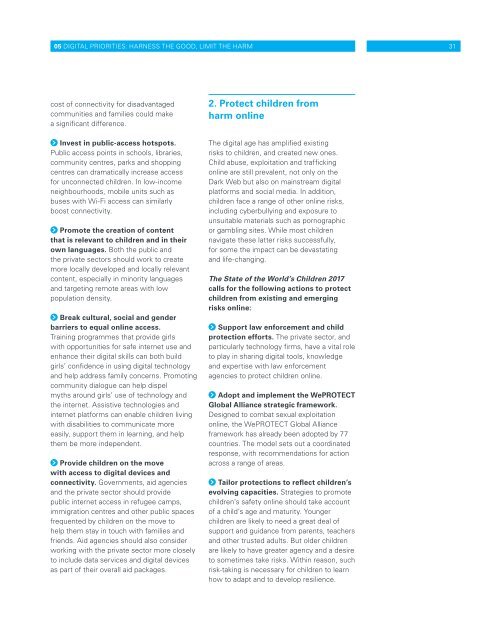SOWC_2017_Summary_En_WEB_FINAL
Create successful ePaper yourself
Turn your PDF publications into a flip-book with our unique Google optimized e-Paper software.
05 DIGITAL PRIORITIES: HARNESS THE GOOD, LIMIT THE HARM 31<br />
cost of connectivity for disadvantaged<br />
communities and families could make<br />
a significant difference.<br />
Invest in public-access hotspots.<br />
Public access points in schools, libraries,<br />
community centres, parks and shopping<br />
centres can dramatically increase access<br />
for unconnected children. In low-income<br />
neighbourhoods, mobile units such as<br />
buses with Wi-Fi access can similarly<br />
boost connectivity.<br />
Promote the creation of content<br />
that is relevant to children and in their<br />
own languages. Both the public and<br />
the private sectors should work to create<br />
more locally developed and locally relevant<br />
content, especially in minority languages<br />
and targeting remote areas with low<br />
population density.<br />
Break cultural, social and gender<br />
barriers to equal online access.<br />
Training programmes that provide girls<br />
with opportunities for safe internet use and<br />
enhance their digital skills can both build<br />
girls’ confidence in using digital technology<br />
and help address family concerns. Promoting<br />
community dialogue can help dispel<br />
myths around girls’ use of technology and<br />
the internet. Assistive technologies and<br />
internet platforms can enable children living<br />
with disabilities to communicate more<br />
easily, support them in learning, and help<br />
them be more independent.<br />
Provide children on the move<br />
with access to digital devices and<br />
connectivity. Governments, aid agencies<br />
and the private sector should provide<br />
public internet access in refugee camps,<br />
immigration centres and other public spaces<br />
frequented by children on the move to<br />
help them stay in touch with families and<br />
friends. Aid agencies should also consider<br />
working with the private sector more closely<br />
to include data services and digital devices<br />
as part of their overall aid packages.<br />
2. Protect children from<br />
harm online<br />
The digital age has amplified existing<br />
risks to children, and created new ones.<br />
Child abuse, exploitation and trafficking<br />
online are still prevalent, not only on the<br />
Dark Web but also on mainstream digital<br />
platforms and social media. In addition,<br />
children face a range of other online risks,<br />
including cyberbullying and exposure to<br />
unsuitable materials such as pornographic<br />
or gambling sites. While most children<br />
navigate these latter risks successfully,<br />
for some the impact can be devastating<br />
and life-changing.<br />
The State of the World’s Children <strong>2017</strong><br />
calls for the following actions to protect<br />
children from existing and emerging<br />
risks online:<br />
Support law enforcement and child<br />
protection efforts. The private sector, and<br />
particularly technology firms, have a vital role<br />
to play in sharing digital tools, knowledge<br />
and expertise with law enforcement<br />
agencies to protect children online.<br />
Adopt and implement the WePROTECT<br />
Global Alliance strategic framework.<br />
Designed to combat sexual exploitation<br />
online, the WePROTECT Global Alliance<br />
framework has already been adopted by 77<br />
countries. The model sets out a coordinated<br />
response, with recommendations for action<br />
across a range of areas.<br />
Tailor protections to reflect children’s<br />
evolving capacities. Strategies to promote<br />
children’s safety online should take account<br />
of a child’s age and maturity. Younger<br />
children are likely to need a great deal of<br />
support and guidance from parents, teachers<br />
and other trusted adults. But older children<br />
are likely to have greater agency and a desire<br />
to sometimes take risks. Within reason, such<br />
risk-taking is necessary for children to learn<br />
how to adapt and to develop resilience.


